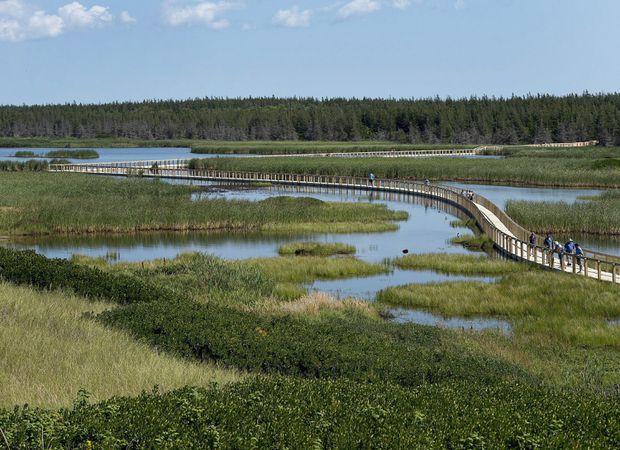Shomporko Online News Desk: Conservation groups have pointed to Canada’s natural ecosystems as key assets in the effort to stem climate change. Now, a scientific study has provided policymakers with a detailed accounting of how those assets could be used to best effect.
The research, published Friday in the peer-reviewed journal Science Advances, identifies a suite of actions targeting forests, grasslands, farmlands and wetlands that could help Canada cut its emissions by 78 megatonnes annually in 2030 – an amount equivalent to more than a tenth of the country’s current annual emissions.
The tactics, known as natural climate solutions, including protecting grasslands, planting trees alongside cash crops, avoiding peatland disturbance, and transforming crop residue into biochar, which is a highly stable form of carbon that can be added to soil to improve its quality. Natural climate solutions were also at the fore Friday as the federal government announced it has started putting seedlings in the ground as part of its commitment to plant two billion trees over the next decade. Roughly 30 million trees are expected to be planted across the country this year.
More than two years in the making, the study was carried out by 38 experts across 16 institutions in Canada and the U.S., including universities, nonprofits, and federal departments such as the Canadian Forest Service and Agriculture and Agri-Food Canada. Nature United, the Canadian affiliate of the global non-profit Nature Conservancy, brought together the researchers to address gaps in data related to natural climate solutions specific to Canada.
“This is really the first-ever comprehensive study of the role of nature in Canada in the fight against climate change,” said Ronnie Drever, co-led author of the study and senior conservation scientist at Nature United. “People understood there was potential across these pathways in the past, but now we have detailed information that’s robustly derived and economic estimates.”

The study is also unusual because it accounts for the albedo effect. When sunlight hits a land surface, some of the solar radiation is reflected and some are absorbed; the darker the surface, the more radiation that’s absorbed, causing localized warming. Although trees absorb carbon from the atmosphere, their canopy also creates a darker land surface. With the help of Massachusetts-based environmental scientist Christopher Williams, researchers were able to calculate the impact of the albedo effect and more accurately quantify the benefits of tree planting.
The study is being released just weeks after Prime Minister Justin Trudeau pledged to cut Canada’s greenhouse gas emissions by 40 to 45 per cent below 2005 levels by 2030 – exceeding the country’s initial commitment to a 30-per-cent reduction under the Paris Agreement.
“If used wisely, this study could be a game-changer,” said Catherine Potvin, a McGill University professor and the Canada Research Chair in Climate Change Mitigation and Tropical Forests. “If the Trudeau government is wise, they should read this with care and include these mechanisms in their plan.”
Ottawa has committed more than $4-billion over 10 years to natural climate solutions, including planting two billion trees, conserving and restoring wetlands, and supporting sustainable farming practices such as cover cropping and decreased use of nitrogen fertilizer. The government is setting up an external advisory committee to ensure that the funding program maximizes emissions reductions while gleaning benefits for biodiversity.
Moira Kelly, the spokeswoman for federal Environment Minister Jonathan Wilkinson, said the government will also invest in efforts to better quantify the contribution of natural ecosystems to the country’s carbon budget and to ensure that the reductions are captured in national emissions reporting.
While the emissions-reporting requirements under the United Nations Framework Convention on Climate Change (UNFCCC) already allow countries to incorporate the impact of a broad range of natural climate solutions, Canada’s national greenhouse gas inventory does not currently include data from all land-management activities.
Dr. Drever explained, for example, that in terms of wetlands, only emissions related to peatland disturbance from peat extraction are counted in Canada’s national inventory report – a document submitted annually to the UNFCCC that covers emissions by sources and removals by sinks.
One of the Liberal government’s most high-profile natural climate solutions is its plan to plant two billion trees over the next decade – a move Dr. Drever and Prof. Potvin described as a long-term mitigation effort because it takes decades for trees to mature and reach their full carbon-sequestration potential. The federal government estimates that its tree-planting will reduce emissions by up to 12 megatonnes annually, but not until around 2050.
“It’s down the road,” Natural Resources Minister Seamus O’Regan said in an interview with The Globe and Mail on Friday. “The best time to plant trees was 20 or 40 years ago. But the second-best time is now.”
In addition to tree planting, the study details a multitude of natural climate solutions that could help Canada meet its climate goals.
Avoiding the conversion of grasslands, which primarily preserves soil carbon stocks, represents the largest opportunity for mitigation in 2030, the study found.
The second-largest opportunity for 2030 comes from avoiding peatland disturbance related to horticultural peat extraction, mine development, or road and seismic line construction; this tactic is among the costliest, with no mitigation available at less than $100 per megatonne of carbon dioxide equivalent. The third-largest opportunity for 2030 is the expanded adoption of cover crops, which allows for increased sequestration of carbon emissions into agricultural soils.
Source_ theglobeandmail.com











